First, quality assurance (QA) is a preventive process ensuring the quality of the product in the future. Quality control (QC) is the process of finding errors in the product with the aim of further correction. In fact, QA is more process-oriented, while QC is focused on the product currently being developed.
To launch a successful product, it is extremely important to know about the QA and QC. In Codica, our quality assurance engineers and testers actively use these methods during and after the software development. In this article, you can learn more about QA and QC, how they differ, and how to use them for your business.
Quality assurance: a brief breakdown
Foremost, quality assurance (QA) is an integral component of website development. Site development and quality assurance software testing should be combined. This is the only way to get a result without delays and inaccuracies. It would be best if you entrusted your projects to quality assurance engineers for everything to go well.
In fact, website quality assurance exists to provide your website customers with a better user interface (UI) and user-friendly functionality. And site owners get a guarantee that their site works flawlessly. The point is to identify and eliminate problems on the site in its infancy.
At Codica, our software testing services ensure that your web app’s functions work according to its behavioral requirements. Each part of the system should provide quality and perform well. Moreover, Codica’s superior quality assurance services help to increase the speed, improve security, reduce development costs, and customer experience of the solution.
How does QA work in a nutshell? The image below shows the quality assurance process.
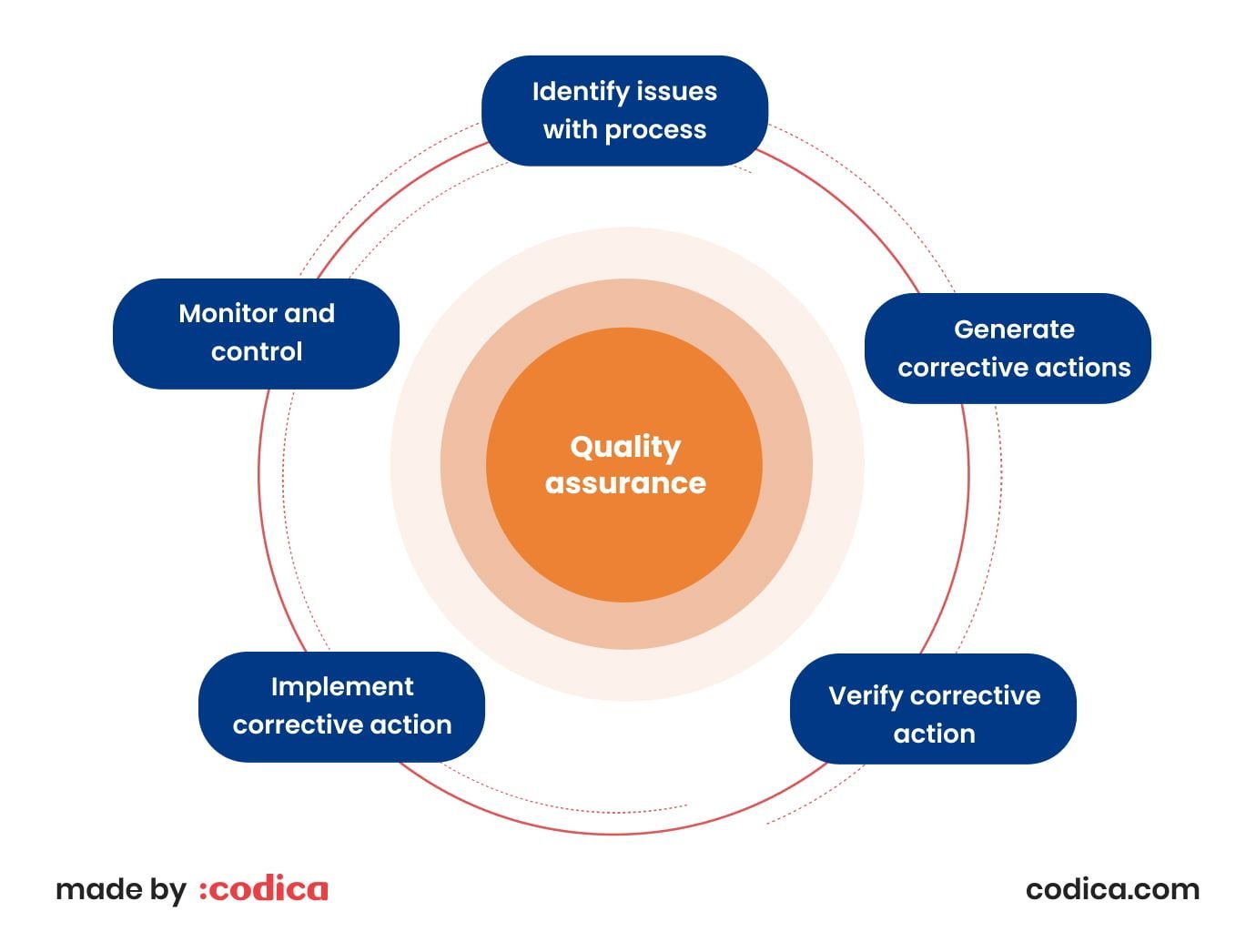
The crucial role of the QA engineer
Hiring a professional QA services team will enable you to reduce costs and increase your solution's efficiencies by adjusting the focus on what needs to be enhanced. At Codica, we will help boost your business by optimizing testing processes, reducing costs, improving product quality, and reducing the delivery time.
These QA professionals check the quality of your software product from the beginning of development to its launch. QAs check whether your project meets the business requirements and look for any hidden bugs and errors to prevent them.
Also, QA experts work to avoid errors before they occur and provide comprehensive information about the status of your product at all stages. Ultimately, the quality assurance engineers check the product for usability and compliance with established standards.
To inspire you, read the exciting interview with a QA engineer at Codica, Dmytro, who cut himself a path straight to our company.

Goals and objectives of QA
At the beginning of software development, the QA engineer must prepare the primary conditions and requirements for the quality of the product. The quality assurance procedure includes creating, modifying, and releasing software with the minimum possible system bugs and defects for the final target audience. QA should provide the methods and technologies of all participants in the software development process to obtain a quality product.
The primary purposes of quality assurance are based on the following:
- Analysis of technical features and requirements for the software product;
- Risk assessment;
- Planning tasks for the software quality improvement process;
- Creation of a database of documents, test environment, and information;
- Verification;
- Analysis of test results, as well as additional reporting documentation.
Key elements of quality assurance
There are two types of methodologies in QA - functional and non-functional testing. These testing methodologies primarily aim to successfully manage software in multiple environments and simultaneously on different platforms.

With functional testing, we can test the app against specific business requirements. This methodology has several tests. These tests are configured so that the software behaves appropriately to use the tests provided by the development team. The methods of this testing are carried out in order and include the following:
- Unit testing. It ensures individual components of a piece of software at the code level are functional and work as intended. However, it is essential to understand that QA engineers are not involved in unit testing. Therefore, developers write unit tests for their code.
- Integration testing. It is all about testing how modules work together to perform functions.
- System testing. This test evaluates integrated systems and discovers previously unnoticed bugs, stability issues, and other significant problems.
- Acceptance testing. This is the last stage of functional testing that satisfies the project or product necessities.
Non-functional tests focus on operational aspects of the software. This includes the following:
- Security testing. This testing phase aims to ensure there are security risks that could compromise the user's data or other sensitive information.
- Compatibility testing. It checks how the application works in multiple environments, from internet browsers to hardware.
- Usability testing. It defines the ease and convenience with which the users can learn, work, and prepare data through interaction with the app.
- Performance testing. It tests the app's stability, responsiveness, and overall performance under various conditions.
We already know the essence of QA. Now, let's see what quality control is and how it differs from quality assurance.
Quality control: a short overview
On the other hand, we have quality control procedures. Therefore, quality control (QC) is essential for any company that manufactures products or provides services. Using QC helps improve customer satisfaction by consistently delivering quality products or services, reducing resource wastage, and increasing company efficiency and profits. Learning more about this concept can help you understand why it's crucial for businesses and your industry.
In comparison, QC is concerned with detecting and correcting defects, while QA is focused on preventing defects by establishing and maintaining robust processes and standards. Moreover, QC is typically performed at specific checkpoints in the production or delivery process, while QA is an ongoing, systematic approach to quality management.
Companies use quality control as a mechanism to have standard operating procedures. Let's look at the picture below for the quality control process in more detail.
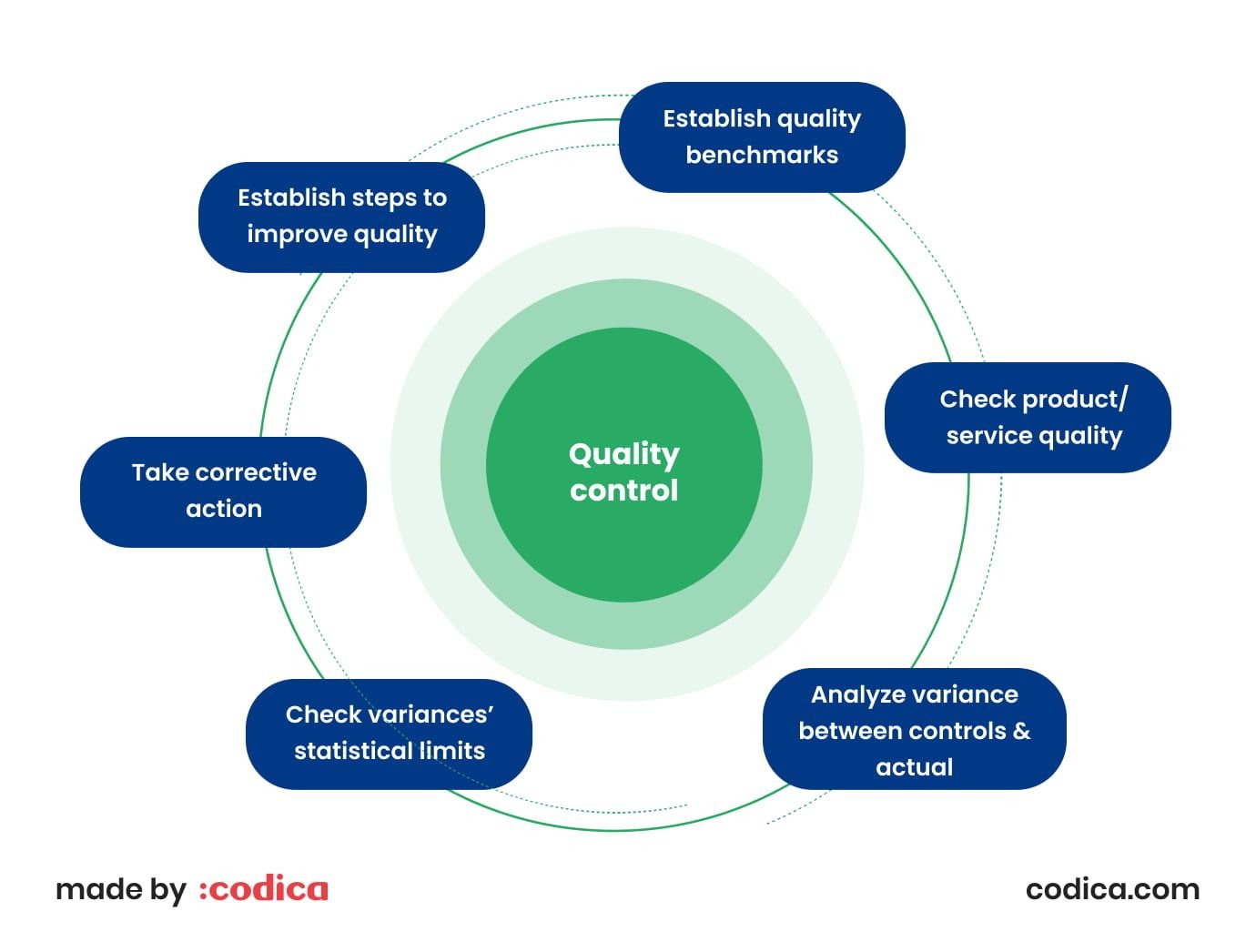
The critical role of the QC engineer
In fact, the QC engineer specialty is a subset of the QA engineer specialty. This specialist ensures the software's compliance with the stated requirements. Also, QC experts provide compliance with the product's predetermined quality criteria as a whole.
Moreover, QC engineers are responsible for determining the product's readiness for production. The goal of the quality control specialist is to form an objective picture of the state of software quality at various stages of development.
Read also: How Automation Testing Increases Execution Speed, Test Coverage, and Effectiveness
Goals and objectives of QC
The quality control process includes test results analysis and detection and elimination of bugs in software. Software quality control allows you to analyze the product's current state and assess the work's overall progress.
The primary destinations of quality control include:
- Inspecting and testing the final product or service to ensure that it meets the required quality standards;
- Analyzing the readiness for the next release;
- Researching the current compliance of the created project's quality from the beginning with the stated requirements;
- If defects are identified during the inspection and testing process, QC takes corrective actions to address these defects;
- Monitoring the performance of the product or service to ensure that it continues to meet the required quality standards over time.
If the quality control department finds many defects, the software development plan is revised, and the bugs are fixed. That is, quality control is the final stage in the development and testing of any software.
Essential parts of quality control
It is worth noting that quality control has some methods for tracking inspections and issues. For example, deviation monitoring allows companies to see how many defects per unit of product they produce and what types of defects occur.
Let's take a closer look at several examples of such methods.
X-bar chart
Control chart is a graph used to determine how a process changes over time. These charts are used to analyze process performance trends over time. It is an essential tool to determine if you need to make any fundamental changes in the production process and avoid specific problems.
Taguchi method
The Japanese engineer and statistician Genichi Taguchi developed this QC method. This method focuses primarily on optimizing design parameters to minimize variation before optimizing the design to beat mean target values for output parameters. Also, the Taguchi method uses unique orthogonal arrays to analyze all the design factors with a minimum of experiments.
Below you can see the Taguchi optimization process.
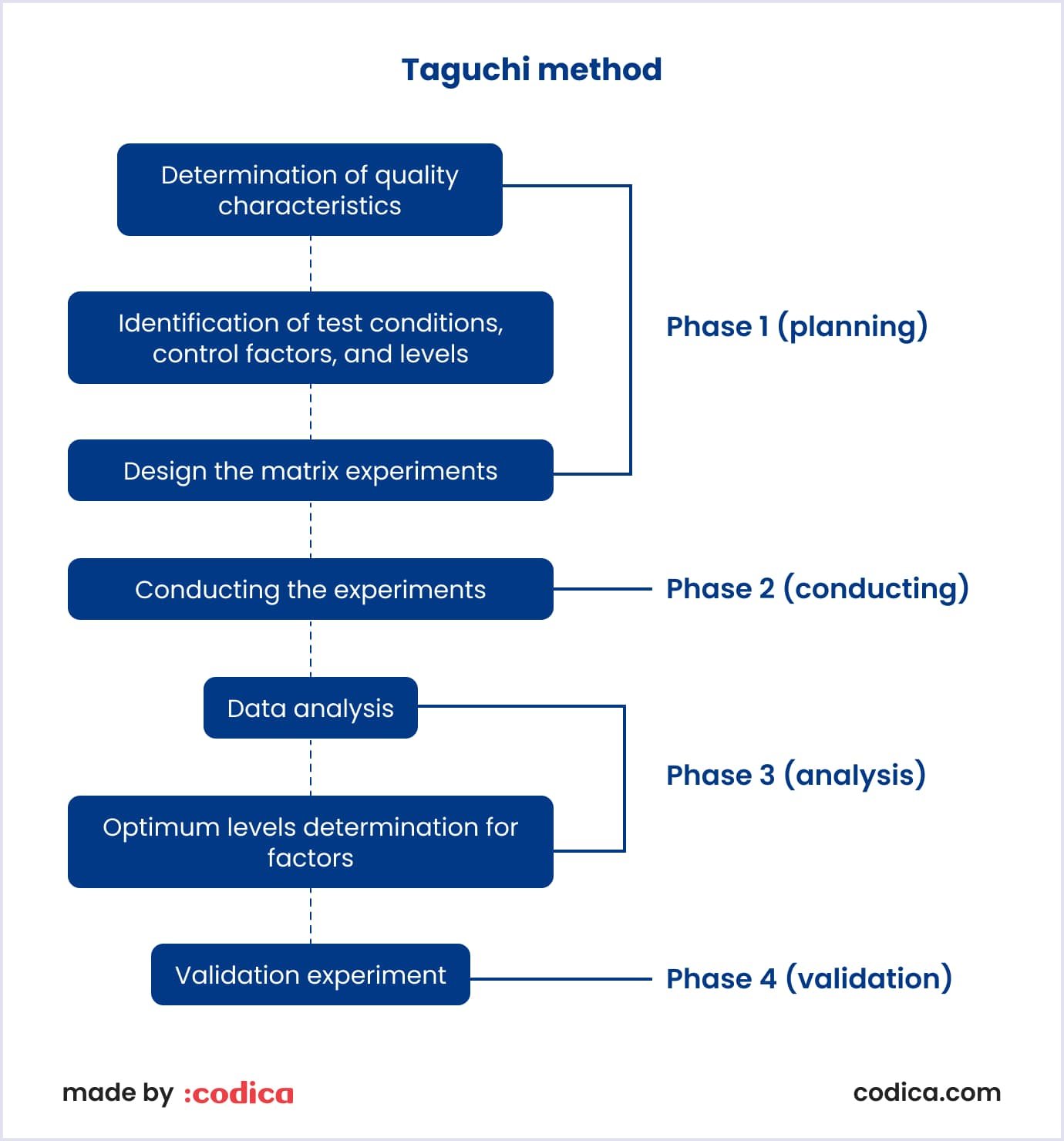
100% inspection method
This approach is a QC process involving inspecting and assessing all product parts. So, this method calls for data about the manufacturing process and software to analyze inventory.

Fundamental differences between quality assurance and quality control
In fact, quality control and quality assurance work together to satisfy your customers' quality expectations, but they have different focuses. They are built on the foundation of quality but their nature is different. So what is the main difference between quality assurance and quality control?
First of all, let's take a look at the comparison image below. Here you can see the distinctive elements and even common insights in QC and QA.

Now, we can focus more on the main differences between QA and QC and explore them in detail.
Proactive vs reactive
The QA process is proactive. It aims to set a framework for minimizing issues and preventing defects before they arise through process design.
On the other hand, the QC process is reactive. Its purpose is to react to the developed product by identifying and either fixing or triaging remaining defects.
Process vs product
One of the primary differentiators in QA vs QC is where the focus of the work lies. First, QA is process-oriented. It primarily focuses on processes and procedures for improving quality and preventing defects before they occur. Then, QC focuses on the product to find flaws that remain after the development process.
Below you can see several examples of each type of activity.
| QA processes | QC processes |
| Documentation | Batch inspection |
| Audits | Product sampling |
| Supplier management | Validation testing |
| Personnel training | Laboratory testing |
| Change control | Software testing |
| Investigate procedures | Beta testing |
System vs parts
QA systems primarily include procedures and methods defined using ISO standards and/or regulatory requirements. For example, it is about supplier audits.
And QC systems measure parts that can be outputs of the system or used to create the final product. For instance, we can mention raw materials from a supplier.
Creation vs verification
The QA process features the definition of standards for each production step: design, manufacturing, assembling, packaging, storage, distribution, marketing and sales, and others. The objective is to produce high-quality products consistently.
On the other hand, QC involves measuring activities to verify the finished product before distribution.
Entire team vs dedicated personnel
QA activities consist of standards for training, documentation, and review throughout the team. Also, these activities are therefore performed by the entire team. They represent an organization-wide effort whereby each team member must follow the defined SOPs (standard operating procedures).
Now, it is interesting to know if there are any common points between QA and QC. Let's check!
Similarities between quality assurance and quality control
Although a significant difference exists between QA and QC, they are closely related and complementary. Let's look at how some components of QC and QA are similar.
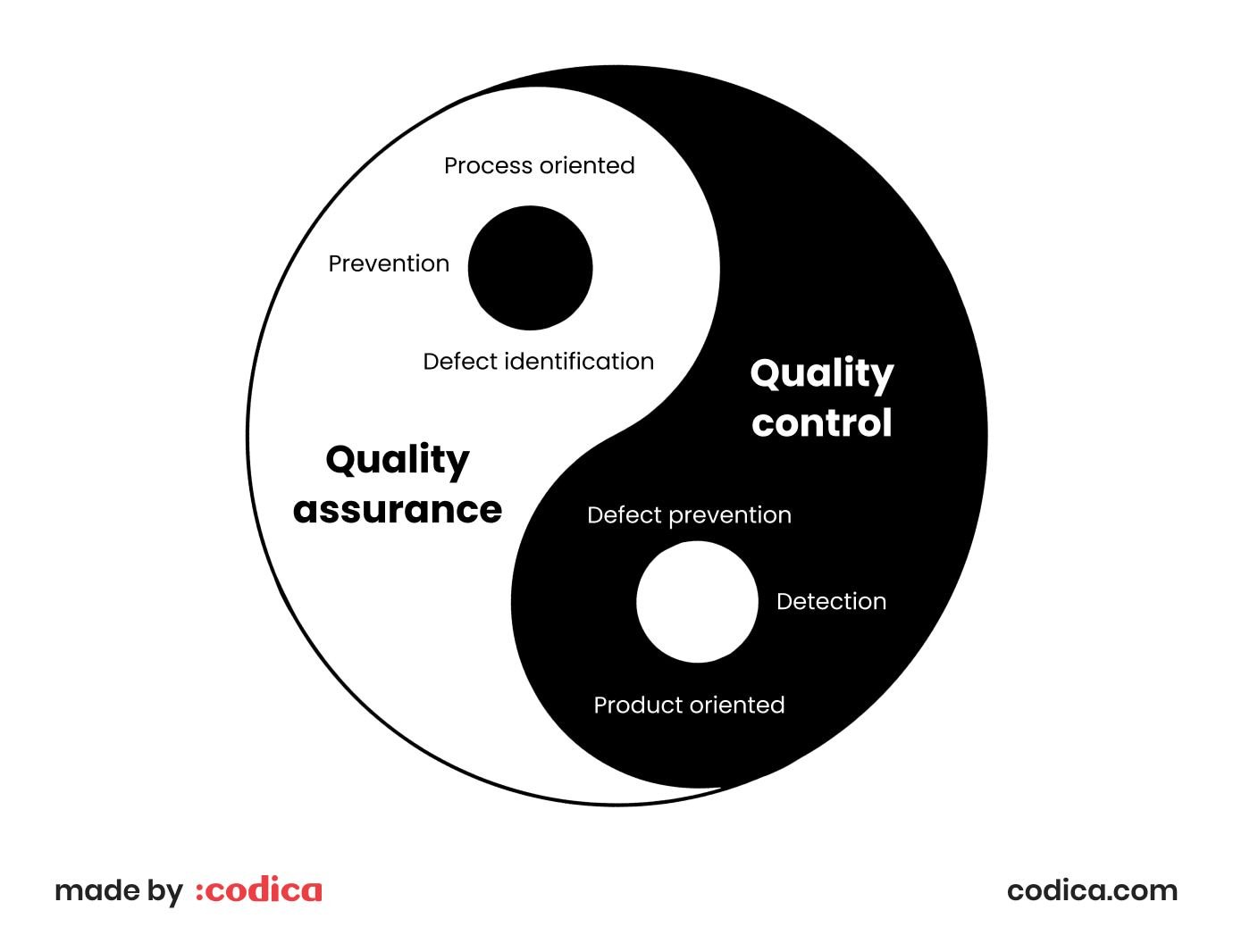
Use policies, procedures, and methodologies
Both approaches follow standards the organization defines to secure high quality, but each features a unique system. QC might involve some experimental, fringe, or UX (user experience) testing techniques that require creativity on the tester's part. However, defect detection and remediation must still be recorded and executed in an organized method.
Secure a high-quality product
QA helps the business strategize for how it will approach digital quality. QC helps ensure the finished product meets expectations. Both QC and QA play vital roles in putting a good outcome in customers' hands and securing revenue for the business.
As a result, both QA and QC help to deliver a high-quality product to the customer. This is important because having satisfied customers can help companies sustain their position in the market.
Prevent significant issues and costs
Defects can be minor, major, or massive disruptions. The cost and time needed to fix the problem correlate with how early you identify the defect.
QA and QC both strive to reduce costs for fixing the issues. QA establishes policies for early detection, and the QC seeks to catch and fix as many bugs as possible in a developed product.
Involve some cost and time investment
Digital quality savings can cost your business more in the long run. This cost is regardless of whether you invest in your own QA and QC teams or enlist the help of a testing partner. It is important to invest in the staff and tools needed to ensure quality throughout the organization.
Continue to improve the organization’s processes
QC and QA provide opportunities for companies to learn where to improve in areas like bug detection, test automation, requirements gathering, and user experience. Your business can improve its processes with each iteration to become more efficient.
Benefits of quality assurance and quality control
It is a good idea to analyze the main advantages of quality control vs quality assurance deeply.
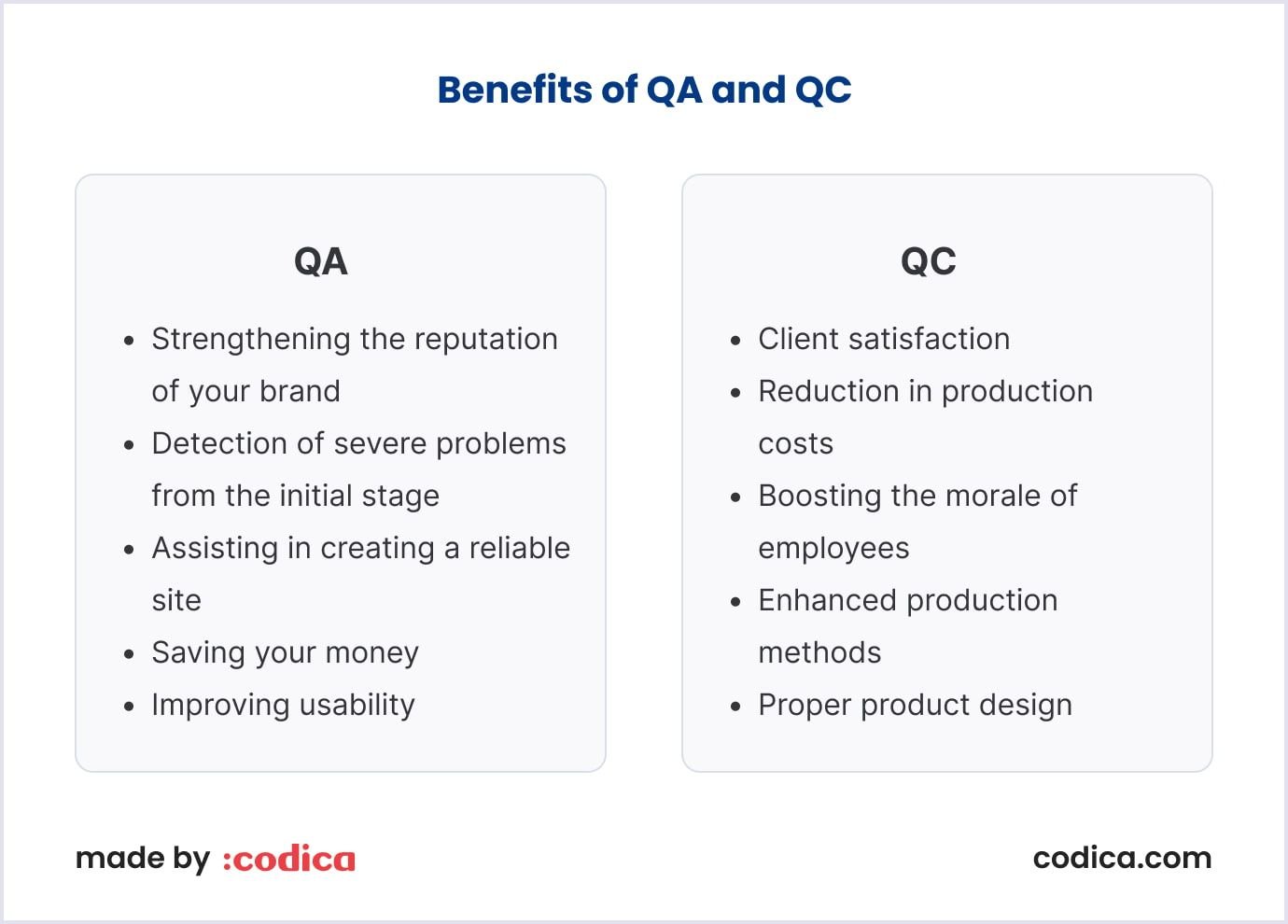
Let's start with quality assurance benefits.
Advantages of QA
The main advantage of QA is structuring the process of creating and testing software. For example, the QA expert knows when to start the testing process and what specific plan to follow.
Next, we'll list why it's a good idea to do site quality assurance and pay a QA engineer.
Strengthening the reputation of your brand
A brand should provide services, take care of its reputation, and maintain it. A website quality assurance service keeps your site in good condition at all times, which means you create better user acceptance testing (UAT). So, UAT is the final stage in web development that helps ensure that all of the requirements are ultimately implemented correctly. Therefore, your business will become an example of excellent work.
According to Zendesk research, over 50% of the respondents expressed their readiness to promptly switch to a competitor when encountering a bad user experience (UX). Simultaneously, a notable 70% of customers are inclined to spend more buying from companies that provide high-quality service.
Detection of severe problems from the initial stage
Often serious errors on the site are discovered during the QA testing and can be fixed immediately. Such a quick response will save your site from hacking, your users from frustration, and you from serious expenses.
Assisting in creating a reliable site
Whether we are talking about quality assurance during the site development stage or after launch, it is a guarantee that there will be no mistakes. With QA, you can be sure that you will end up with a website that works perfectly.
Saving your money
QA testing saves you unnecessary expenses. It's cheaper to do a website QA and fix a bug immediately than to find it after it costs you money. And after that, you will still have to spend money on its correction.
Improving usability
Remember that many companies provide similar services or sell parallel products. To get around them, you need to improve the user experience (UX). Are you still trying to understand why UX is so important? Let’s look at our other blog article about the UX Discovery Process to clear all your doubts. So, quality assurance in web development is precisely the creation and optimization of the UX and UI of your site.
Advantages of QC
On the other hand, quality control is also an essential technique in the hands of management to maintain product quality. Accordingly, QC has its benefits. Let's look at them!
Client satisfaction
Using quality control tools and processes ensures that your customers will be as satisfied as possible with the products they receive from you. The logic is elementary: the better the quality of your products, the happier the clients will be and the more money you will make selling them.
Reduction in production costs
Quality control helps companies save time and money. How? By introducing quality control into the production process, the extra time and money spent on inferior products can be used to fulfill another order in less time and with less money.
Boosting the morale of employees
Quality control ensures that employees perform quality work. When management cares about employees and provides them with good working conditions, they are more likely to deliver the best quality results.
Enhanced production methods
You can also increase sales through sound quality control systems. If your company can produce a product that meets customer needs and requirements, you will have more sales success than a company without an effective quality control system.
Proper product design
Another significant benefit of quality control is that it helps companies use high-quality components to make the final product. Therefore, a product that has a good design also becomes safer.

Quality assurance vs quality control tools and techniques
For over 8+ years, our experienced QA team has used the top software testing tools and practices to build high-quality web products.
At Codica, we use the following management tools:
- Jira;
- Confluence;
- Trello;
- Monday;
- Asana;
- Google Docs;
- Testrail;
- Practitest.
For example, in our portfolio you can find the workday time tracking tool our experts created. This work time tracker improved our team’s performance and velocity of internal company processes.
We integrated our TimeBot for Slack with Trello. Moreover, our specialists customized seamless bundling with Trello to simplify the time-tracking process. So, Trello’s tickets with attributes and statuses serve as a description of logged hours.
Below you can see the integration of this time-tracking software with Trello.

Our specialists delivered auto-generated reports according to set intervals and triggered tasks. So, generating and sending reports allows our specialists to handle the teams’ performance across different projects. With TimeBot, we can quickly create teams, add employees, get summary reports, and handle client billing and communication. Finally, project managers have more opportunities to monitor the team workload and manage the tasks.
After all, our products are always safe and reliable because we always care about quality. To guarantee the best quality of our projects, we use advanced technologies. Let's take a look at the tech stack elements in more detail.
The tech stack components of QA and QC
We provide consultations on every stage of the web app development process and build products following the best industry standards. Our experts use Chrome DevTools, BurpSuite, Fiddler, and JMeter for manual testing. Moreover, we involve Playwright, Mailtrap, and Git for automation testing. Finally, Postman and XCode are our great helpers working with APIs (application programming interfaces) and native applications.
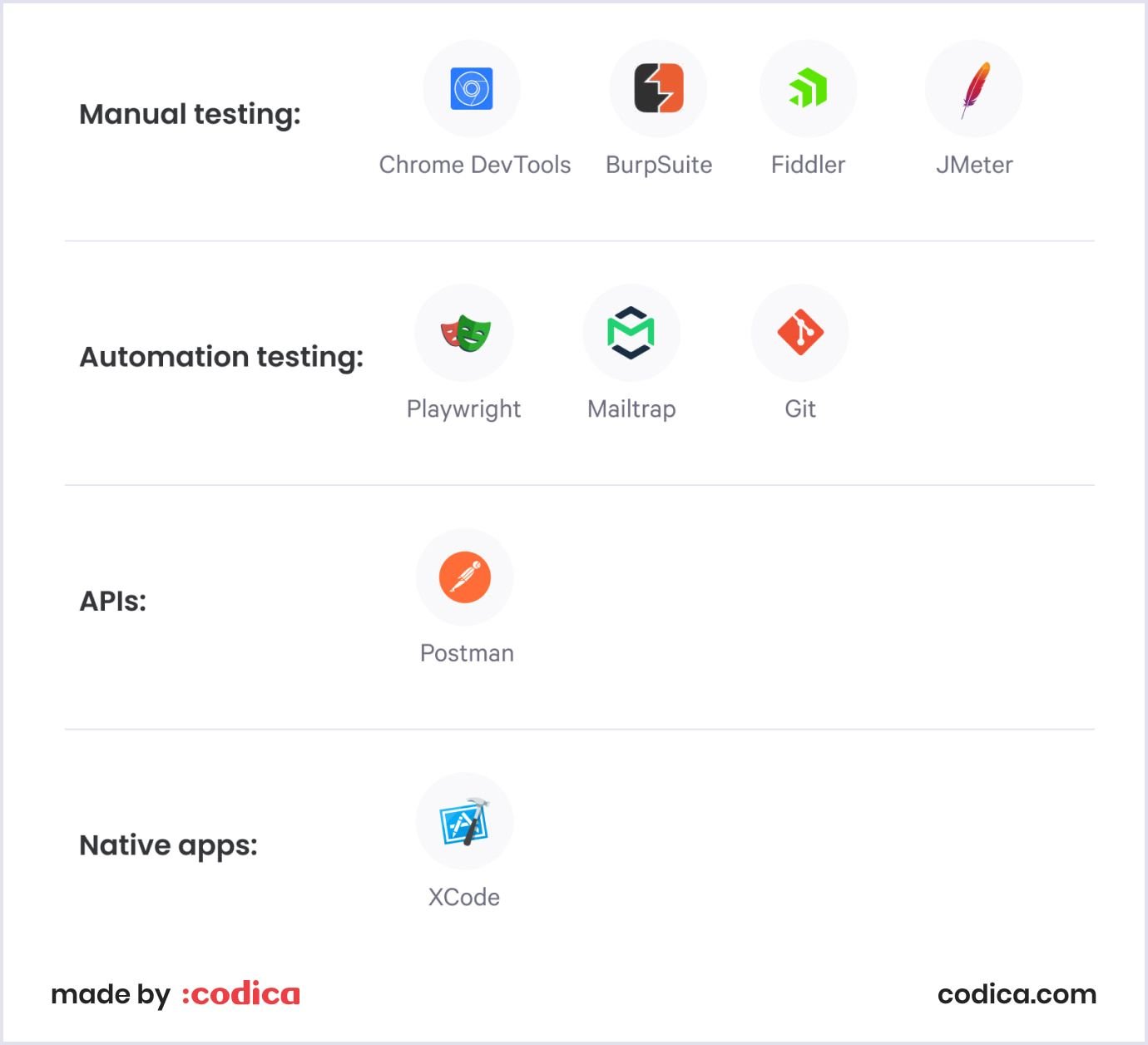
Essentially, QC and QA tools are practical and efficient in helping organizations understand their process, products, and systems. First, companies use quality assurance tools to enhance the processes involved in production. Then, they also employ QC tools to identify and correct defects.
Let's define quality control vs quality assurance tools separately for better understanding.
There is a QA tools list:
Quality audits
They are a systematic, independent, documented review and evaluation of an organization’s quality management system. Process audit, product audit, and system audit are the three main types of quality audits.
Below you can also see the four stages of quality audits.
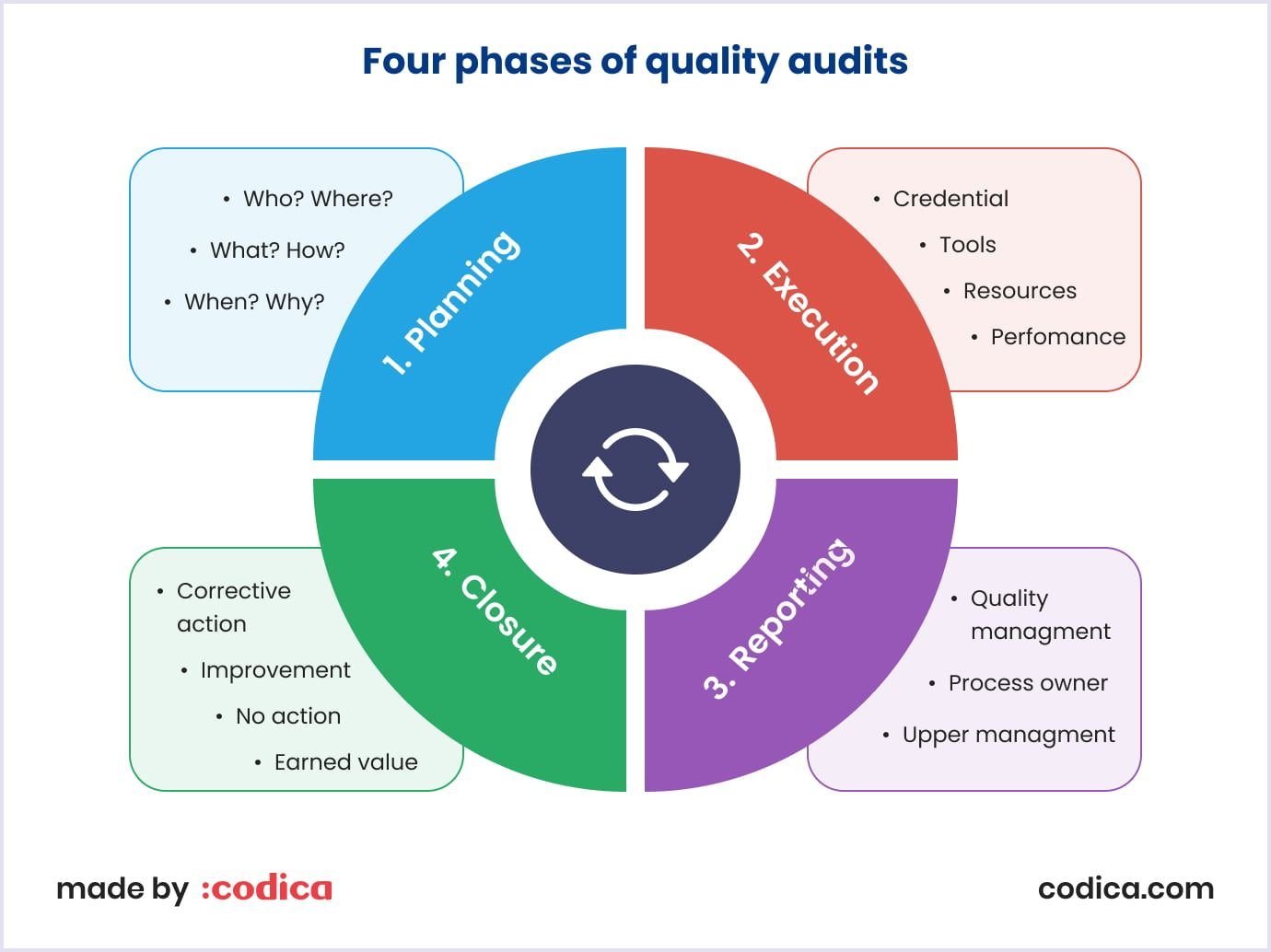
Process analysis
It is an efficient technique for reviewing and understanding every detail of business processes. The process analysis includes several essential steps. For example, it is vital to identify the process that needs improvement, set up your team, create a business process diagram, and model the process you’re aiming for.
Below you can see a step-by-step guide to the process analysis.
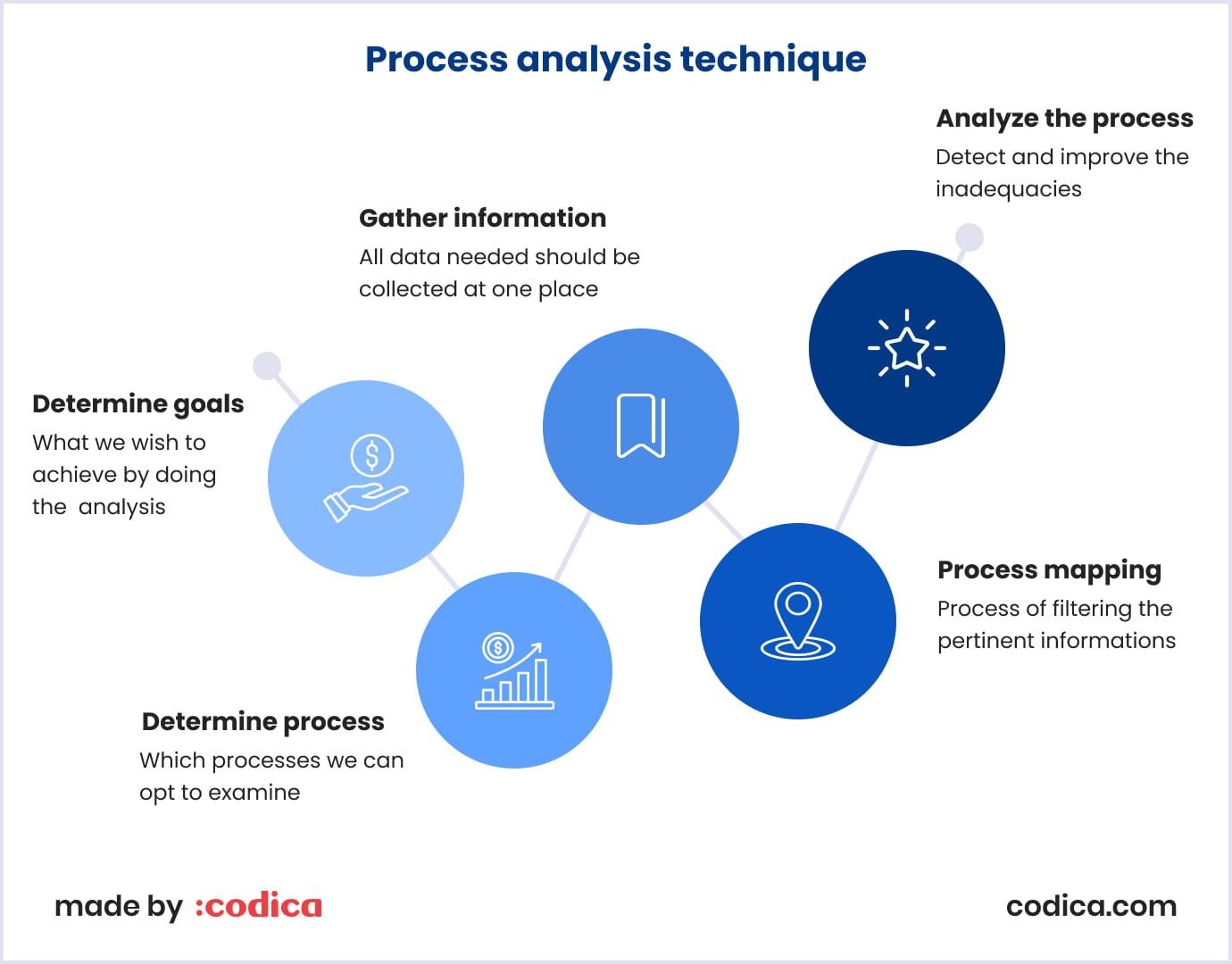
Now, let’s check the QC tools list:
Scatter diagram
This diagram shows the connection between two variables by planning related data. The scatter diagram graphs pair numerical data with one variable on each axis to determine their relationship. The points will fall along the line or curve if the variables are correlated.
By analyzing the pattern on the scatter diagram, quality control professionals can determine the nature of the relationship between the variables. For example, they may find that as one variable increases, the other variable decreases, or the two variables have a positive correlation, meaning that as one variable increases, so does the other variable.
With dependent Y-axis values on the diagram and independent X-axis values, each dot represents a specific point of intersection. In the diagram below, the dots will illustrate the relation between the two variables when joined.
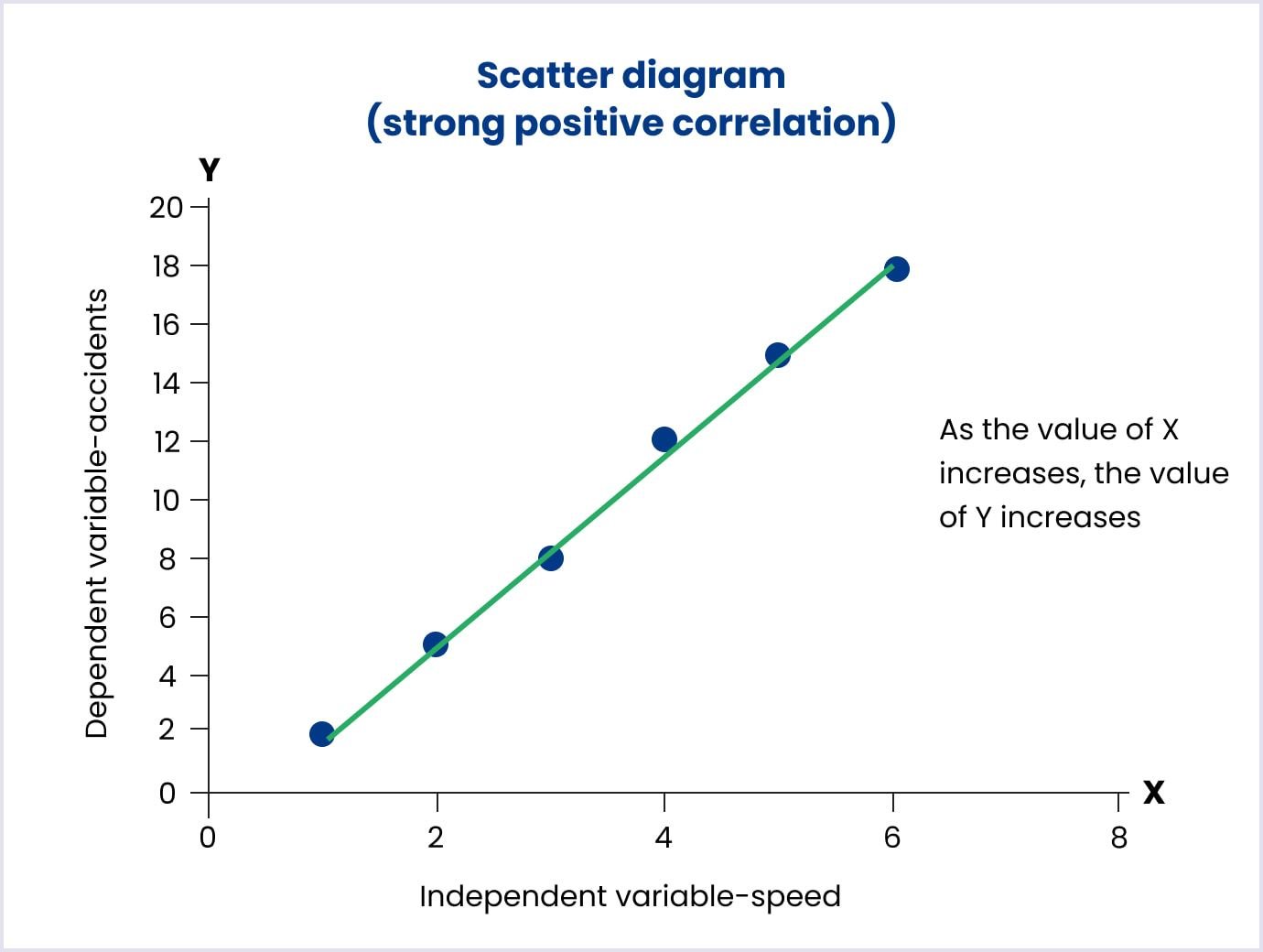
Control charts
This chart depicts whether sampled products or processes meet their intended specifications. The Y-axis shows the degree to which the variance of the tested attribute is acceptable. The X-axis tracks the samples tested. By analyzing patterns of variation, one can know if defects are happening randomly or systematically.
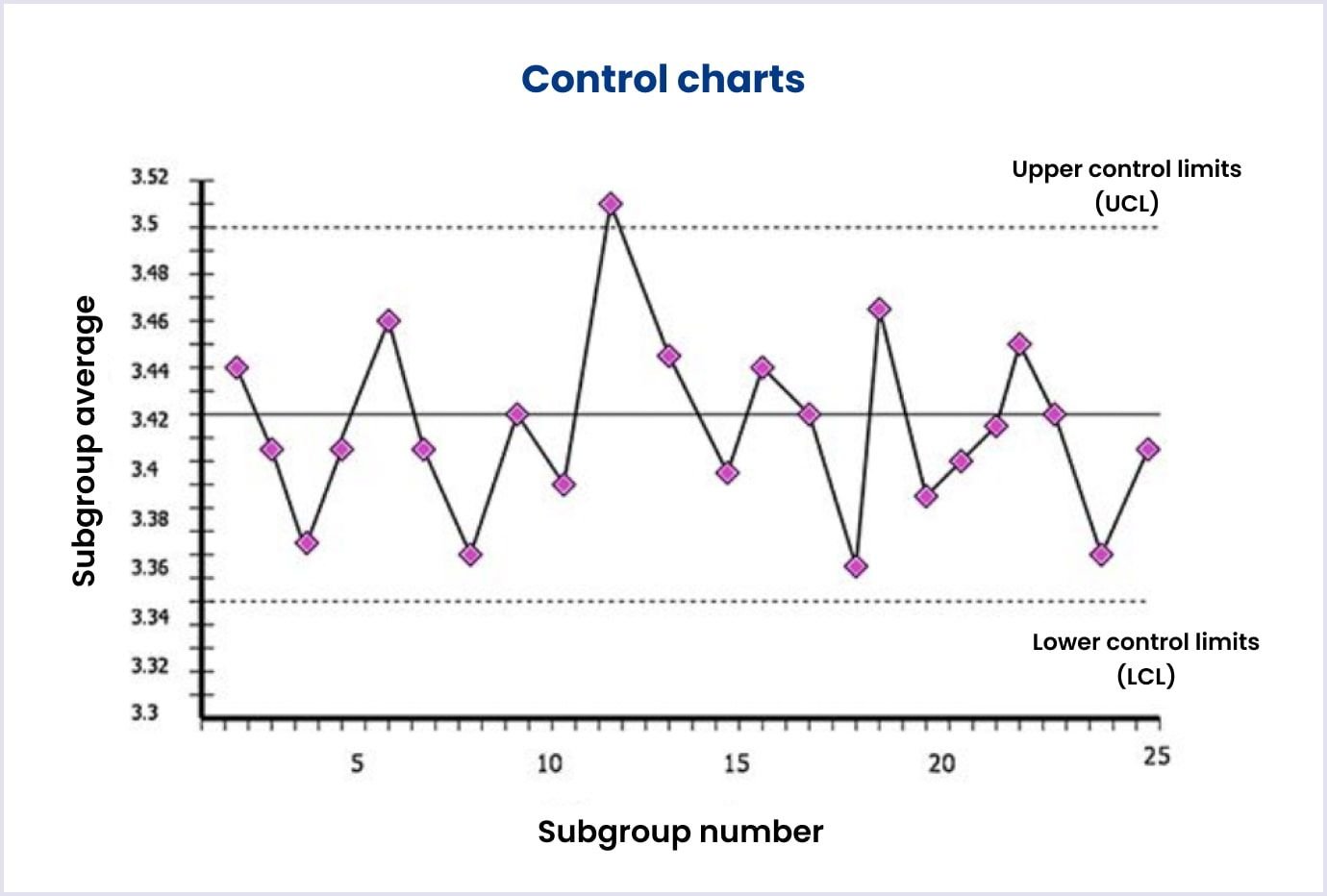
Histogram
We can use this histogram to display the distribution frequency for data elements. It shows the variation and the range of variation within a process. In a bar graph-like structure, each bar within a histogram represents a group, while the bar height represents the data frequency.
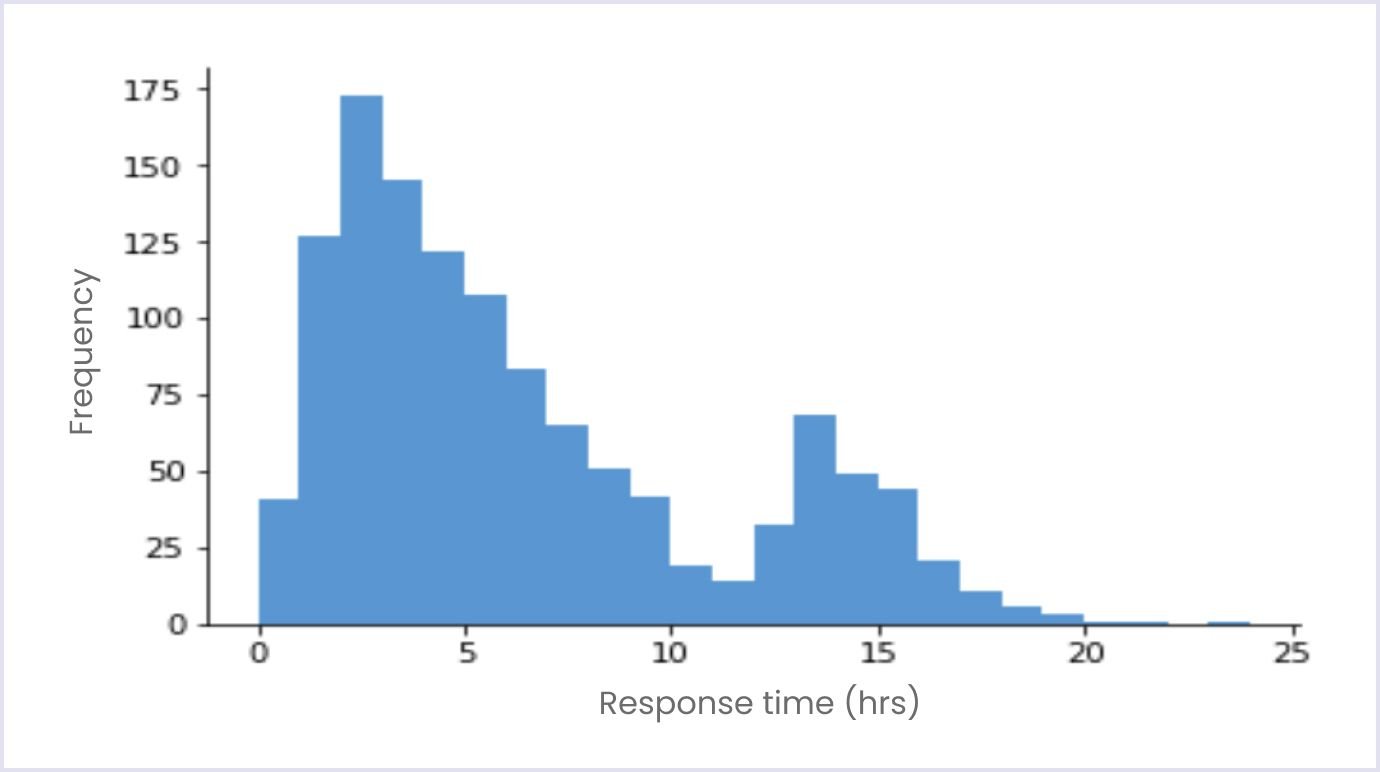
Flow charts
These charts are a great idea to help employees and organizations understand the finite details of a process. Also, it is a diagram of the flow of production or service processes through a system.
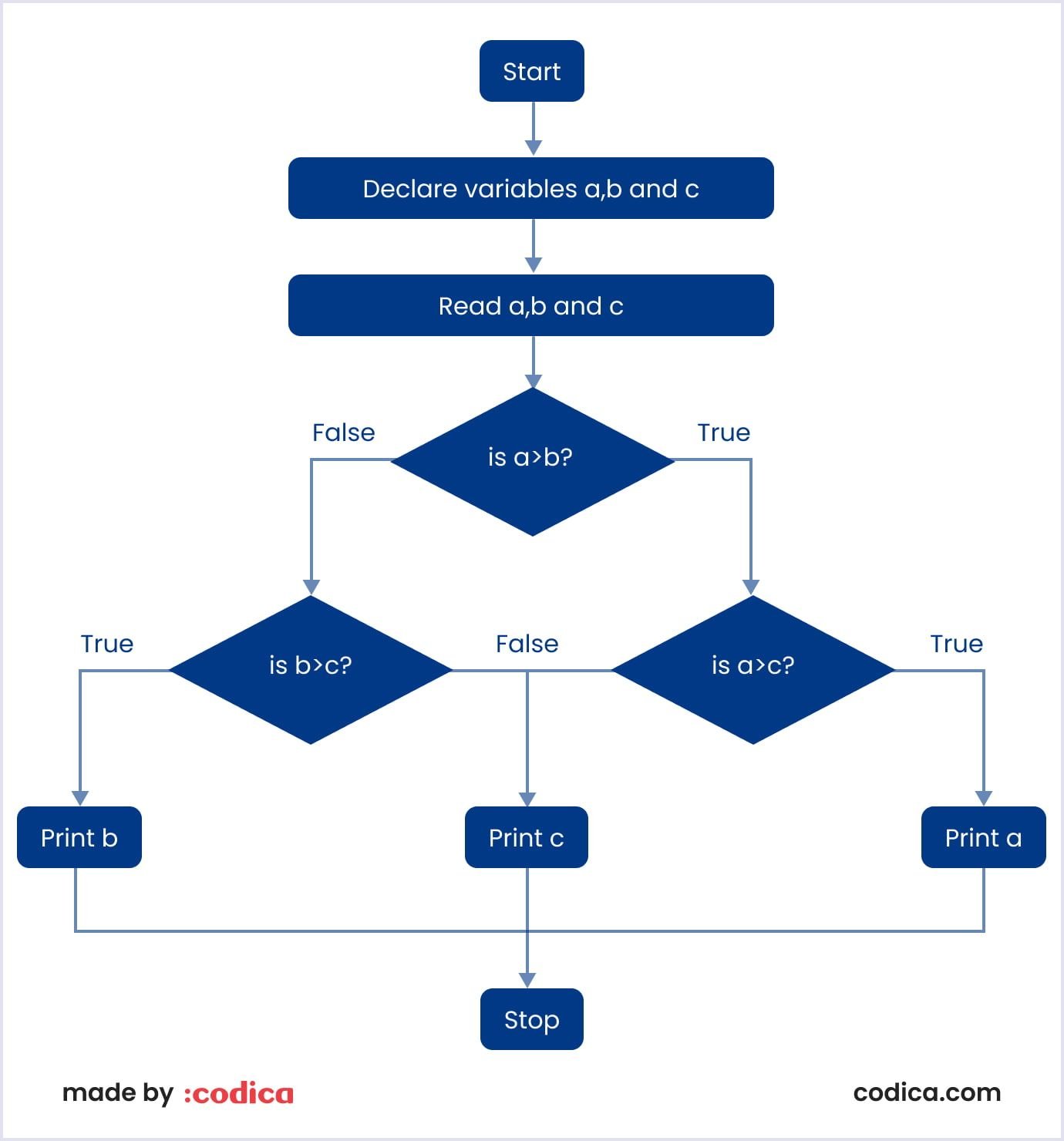
Moreover, quality control tools also include checklists, Pareto diagrams, and cause and effect analyses.
Companies prioritize QA and QC to maintain a competitive advantage
Penny wise, pound foolish! It is impossible to create a website that will work perfectly and without a single error. Even if you choose the best web development agency, inaccuracies will always exist.
Therefore, a QA or QC engineer's job is to spot and fix the errors before the project is handed over to you. First, to get an ideal result and product, companies need QC and QA of the site. Thus, quality assurance and quality control ensure the product is what you want.
With quality assurance and control in production, companies save time, money, and resources. Therefore, assessing the type of operation and the resulting products is the prerogative of most companies.
At Codica, testing plays a vital role in the software development life cycle as it involves essential quality control techniques. The process of software testing encompasses planning, development of tests, execution of the web solution, and analysis of the resulting outcomes. So, our quality assurance engineers (QAs) diligently search for bugs within the software. But how exactly?
Testing strategy. QAs examine the specification document and seek clarifications regarding the sequence of events, ensuring that all details are meticulously addressed. Also, the QAs formulate a testing strategy, which serves as a comprehensive guideline informing all testing-related decisions.
The primary objective of QA engineers is to achieve a clear understanding of the client's requirements to deliver precisely what was requested. Typically, the testing phase involves close collaboration with the clients to eliminate potential ambiguities in their vision.
Acceptance criteria (AC). The project manager (PM) broke down the scope into individual tickets. The QA experts then proceed to define the Acceptance criteria (AC) based on the provided specifications. Once the AC is documented, the developers take up the individual tickets, initiating the software development process.
Occasionally, clients may introduce new requirements during the software development process. In such cases, the QAs are responsible for revising and updating the AC accordingly.
Checklists and test cases. At Codica, QAs use checklists and test cases. Checklists offer flexibility and are suitable for updates, making them a more reasonable choice in specific scenarios. They outline the criteria that the web product must meet to achieve satisfactory results. On the other hand, test cases provide comprehensive descriptions of test scenarios, including steps and prerequisites.
Regression testing. Subsequently, regression testing takes place, verifying that introducing new functionality has not caused any issues within the app. Regression suites consist of minimal test cases to validate critical project functionality. Conducting regression testing involves thoroughly reviewing all functions within the project. This ensures that both the new and previous versions of the project function properly.
Once it is confirmed that both versions are functioning as intended, the project moves to the production environment. So, the QAs perform an essential check directly on the production environment.

To sum up, businesses closely monitor how a product is made and thereby better analyze where they should focus their attention and resources. Experience has shown that manufacturers with significant experience in providing both warranty and quality control have faster turnaround times, a reliable manufacturing process, and loyal customers. As a result, quality assurance and control are paramount to the company's long-term success.
You may also like: MVP Testing: Techniques, Strategies, and Plan
Importance of QA and QC in software testing
Companies may neglect QA and QC in software development. What consequences should they expect? Software bugs can lead to millions of dollars or reputation losses for your product. Let's check the role of quality assurance vs quality control in software testing.
The role of QA and testing in software development:
- Preventing possible issues;
- Saving time and money;
- Enhanced security;
- Better UX;
- Faster development;
- Easier updating.
Regarding the importance of QC in the software development process, we can say the following crucial points:
- Places greater focus on the quality of the product analysis.
- Utilized to test the software/product by calling it up.
- Testing team engaged in the software testing.
- Assesses the reliability of the end product.
- Applied to find defects, errors in the product that is being built.
- Functional testing, automation testing, and others are used.
Without QA and QC, there is a risk of developing a product that behaves unexpectedly in its environment. A poorly made product is hard to update, and there is a high chance that you’ll have to rebuild the entire system from scratch if you want to add or remove something.
Summary
Creating the best software and maintaining its quality are essential elements in the life cycle of any web product. Therefore, we constantly adhere to the developed standards to maximally satisfy our customers' requests for the software's functionality.
The concepts of QA and QC are closely related and can work in addition to each other. Their main distinctive points lie exclusively in the implementation of specific parameters. Quality assurance is created before software implementation when the process is only related to analytics. Quality control is developed and analyzed when part of the software is ready.
Thus, QC and QA engineers must test how each software component functions separately. Also, they analyze these components' holistic interaction when assembled into a single verification methodology.
With our QA services, each system part will provide quality and perform well. Feel free to contact us, and our experts will give outstanding testing services through a deep understanding of your business needs.
